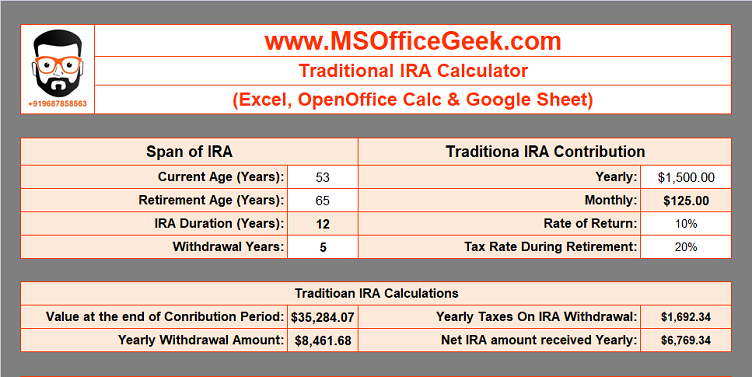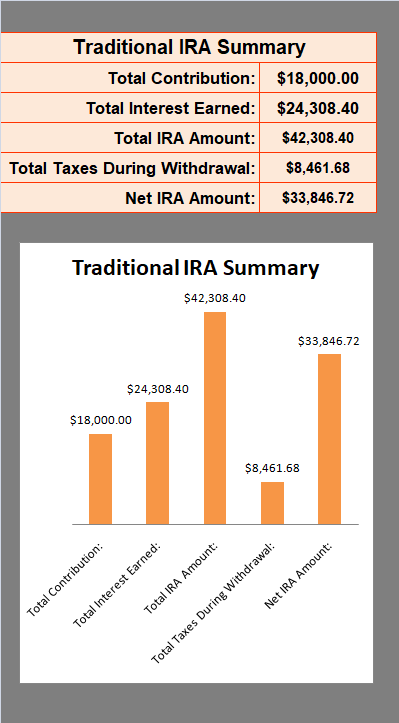Download Traditional IRA Calculator 2022 in Excel, OpenOffice Calc, and Google Sheets to easily estimate the future value of your Traditional IRA.
Moreover, this template also displays the schedule of payments along with interest earned during the contribution period. It also displays the withdrawal schedule during the retirement period.
Additionally, this article consists of other important information about the tax-deductible contribution limits as well as Modified AGI limits for Traditional IRAs.
Table of Contents
What Are Traditional IRAs?
A Traditional Individual Retirement Account (IRA) is a kind of individual retirement account. Investing in a typical IRA allows you to grow your money tax-free.
Moreover, you are eligible for a tax deduction in the contribution year for that particular year if you have a traditional IRA. You only pay taxes on your investment earnings when you withdraw them during your retirement years.
This Traditional IRA Calculator 2022 helps you to define the amount of savings you need to invest each year to achieve your retirement goals.
Eligibility for Tax Deductible Contribution
Generally, if you don’t plan to take the deduction of the contribution to a Traditional IRA, there is no contribution limit.
On the contrary, you can claim Traditional IRA contributions as a deduction on your Federal Income Tax Return if you meet certain guidelines.
Let us discuss the eligibility criteria for tax-deductible contributions in Traditional IRAs.
Modified AGI Limits for 2022
Contribution and Modified AGI limits differ based on whether you have a retirement plan with your employer or not. You can also use our MAGI Calculator 2022 to calculate your MAGI.
Modified AGI for individuals NOT Covered by a Retirement Plan at Work
If you are single, head of household, or qualifying widow(er) then the Modified AGI limit doesn’t apply. Having any MAGI score, you can take a full deduction up to the amount of your contribution limit.
Moreover, if married filing jointly or separately with a spouse who is not covered by a plan at work the Modified AGI limit doesn’t apply. Similar to the above, you can take a full deduction up to the amount of your contribution limit.
But, rules are different for married filing jointly with a spouse who is covered by a plan at work.
If your MAGI score is $204,000 or less, you are eligible for a full deduction up to the amount of your contribution limit.
In case, your MAGI is more than $204,000 but less than $214,000 then you are eligible for a partial deduction. But if the MAGI score is more than $214,000 you cannot take any deduction.
Moreover, married filing separately with a spouse who is covered by a plan at work, then the limit is very low. In such cases, if the MAGI score is below $10,000 then you can take a partial deduction. Whereas, if the MAGI score is above $10,000 then you cannot take any deductions.
It is important to note that if you file separately and did not live with your spouse at any time during the year, your IRA deduction is determined under the “Single” filing status.
Modified AGI for individuals Covered by a Retirement Plan at Work
If you are single or head of household and have a MAGI score of $68,000 or less, you can take a full deduction up to the amount of your contribution limit.
But, if your MAGI is greater than $68,000 and less than $78,000, you are eligible for a partial deduction. And if the MAGI score exceeds $78,000 then you cannot take any deduction.
For married filing jointly or qualifying widow(er), if the MAGI Score is $109,000 or less, then you can take a full deduction up to the amount of your contribution limit.
Moreover, if the MAGI score is more than $109,000 but less than $129,000, then you can take a partial deduction. But, if the MAGI score is $129,000 or more, then you cannot take any deductions.
Furthermore for married filing separately having a MAGI score below $10,000 can get a partial deduction. Whereas, if the MAGI score is above $10,000 then you cannot take any deductions.
Similar to the above section, if you file separately and did not live with your spouse at any time during the year, your IRA deduction is determined under the “Single” filing status.
Contribution Limits
According to IRS,
For 2022, 2021, 2020, and 2019, the total contributions you make each year to all of your traditional IRAs and Roth IRAs can’t be more than:
- $6,000 ($7,000 if you’re age 50 or older), or
- If less, your taxable compensation for the year.
Download Traditional IRA Calculator 2022 (Excel, OpenOffice Calc & Google Sheets)
We have created a simple and easy-to-use Traditional IRA Calculator 2022 with predefined formulas and functions. Just insert the applicable amounts and it will calculate the future value at retirement.
Download by clicking below on the desired format:
Additionally, you can also download Federal Income Tax templates like Adjusted Gross Income Calculator 2022, Itemized Deduction Calculator 2022, Recovery Rebate Credit Calculator, Employee Retention Credit Calculator 2021, Paycheck Calculator, and IRS Compliant Mileage Log Template 2022.
Furthermore, feel free to contact us for the customization of this template as per your requirement. We also design new templates based on your needs. You can hire us for our services on Fiverr or directly contact us at info@msofficegeek.com.
How to Use the Traditional IRA Calculator 2022?
This template consists of six sections. Let us discuss each section in detail.
Span of IRA
To calculate the SPan of IRA, insert the following details:
Current Age (Years)
Retirement Age (Years)
IRA Duration (Years)
Withdrawal Years
When you enter your current age as well as retirement age, it will calculate the IRA duration. Enter the Withdrawal of retirement in which you want the IR to be paid.
Traditional IRA Contribution
In this section, you need to insert the following items:
Yearly Contribution
Monthly Contribution
Rate of Return for IRA
Tax Rate During Retirement Period
Insert the total amount of contribution per year and it will calculate the monthly contribution amount. Enter the rate of return you expect from the traditional IRA. This will help to further calculate your Interest received each year.
You also need to enter the estimated tax rate that will apply to you during the retirement period. This will help to calculate the tax on your IRA withdrawals.
Traditional IRA Calculations
This section consists of the following heads:
Value at the end of Contribution Period
Yearly Withdrawal Amount
Yearly Taxes On IRA Withdrawal
Net IRA amount received Yearly
Value at the end of the contribution period is calculated using the FV function. The formula used here is =FV(G9, D9, -G7, 0, 1).
The Yearly Withdrawal Amount is calculated using the PMT function. The formula used here is =PMT(G9,D10,-D12,0,1).
Yearly Taxes on IRA withdrawals is calculated based on the percentage entered in the Traditional IRA Contribution section.
Moreover, the Net IRA withdrawal amount yearly is calculated by subtracting the taxes from the yearly distribution amount during retirement.
Traditional IRA Contribution Schedule
It consists of the following columns:
Year
Contribution
Interest
Balance
All the columns consist of predefined formulas.
This section is auto-populated based on the information given in the Traditional IRA Contribution section. If you already have an IRA balance, then enter in the first row or else enter 0.
If you have more years of contribution you can drag the lines and copy the formulas.
Traditional IRA Withdrawal Schedule
It consists of the following columns:
Year
Withdrawal
Interest
Balance
All the columns consist of predefined formulas.
Like the Contribution Schedule, this section is also auto-populated. You don’t need to enter any amounts here. If you have more years of withdrawal you can drag the lines and copy the formulas.
It is important to note that, during the distribution years also you will receive interest on the balance amount after withdrawal until 0.
Traditional IRA Summary
This section displays the summary of your Traditional IRA from contribution to withdrawal. It consists of the following heads:
Total Contribution
Total Interest Earned
Cumulative IRA Amount
Total Taxes During Withdrawal
Net IRA Amount
Frequently Asked Questions
Source: www.IRS.gov
If you like this article, kindly share it on different social media platforms. So that your friends and colleagues can also benefit from the same. Sharing is Caring.
Moreover, send us your queries or suggestions in the comment section below. We will be more than happy to assist you.
Disclaimer: This article is for information and educational purpose. Information provided here shall not be treated as tax advice. Kindly consult a tax expert before filing your tax return.






